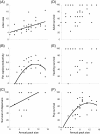Do social groups prevent Allee effect related extinctions?: The case of wild dogs
- PMID: 23496951
- PMCID: PMC3626796
- DOI: 10.1186/1742-9994-10-11
Do social groups prevent Allee effect related extinctions?: The case of wild dogs
Abstract
Background: Allee effects may arise as the number of individuals decreases, thereby reducing opportunities for cooperation and constraining individual fitness, which can lead to population decrease and extinction. Obligate cooperative breeders rely on a minimum group size to subsist and are thus expected to be particularly susceptible to Allee effects. Although Allee effects in some components of the fitness of cooperative breeders have been detected, empirical confirmation of population extinction due to Allee effects is lacking yet. Because previous studies of cooperation have focused on Allee effects affecting individual fitness (component Allee effect) and population dynamics (demographic Allee effect), we argue that a new conceptual level of Allee effect, the group Allee effect, is needed to understand the special case of cooperative breeders.
Results: We hypothesize that whilst individuals are vulnerable to Allee effects, the group could act as a buffer against population extinction if: (i) individual fitness and group fate depend on group size but not on population size and (ii) group size is independent of population size (that is, at any population size, populations comprise both large and small groups). We found that both conditions apply for the African wild dog, Lycaon pictus, and data on this species in Zimbabwe support our hypothesis.
Conclusions: The importance of groups in obligate cooperative breeders needs to be accounted for within the Allee effect framework, through a group Allee effect, because the group mediates the relationship between individual fitness and population performance. Whilst sociality is associated with a high probability of Allee effects, we suggest that cooperative individuals organized in relatively autonomous groups within populations might be behaving in ways that diminish extinction risks caused by Allee effects. This study opens new avenues to a better understanding of the role of the evolution of group-living on the probability of extinction faced by social species.
Figures



References
-
- Darwin CR. The origin of species. London: John Murray; 1859.
-
- Allee WC. Cooperation among animals. New York: Henry Schuman; 1951.
-
- Wynne-Edwards VC. Animal dispersal in relation to social behaviour. Edinburgh: Oliver & Boyd; 1962.
-
- Gardner A, Foster KR. In: Ecology of social evolution. Korb J, Heinze J, editor. Germany: Springer-Verlag; 2008. The Evolution and ecology of cooperation – history and concepts; pp. 1–36.
LinkOut - more resources
Full Text Sources
Other Literature Sources

